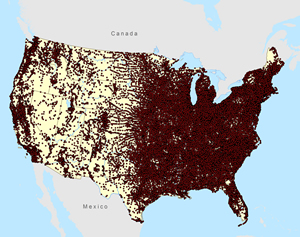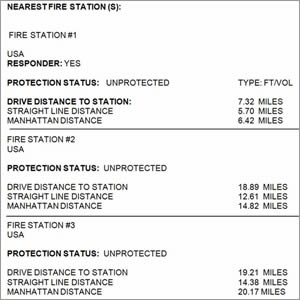Counting on Risk
Insurance Underwriters Turn to GIS for More Accurate Risk Analysis
Highlights
- ArcGIS Server helps analysts evaluate the risk of fire peril and provide the data for FIRESAFE.
- ArcGIS and Microsoft SQL Server help maintain very large databases with millions of records.
- ArcGIS Server creates, manages, and distributes Explore's GIS services over the web.
To build insurance pricing models that are equitable and fair depends heavily on accurate location-based information. Insurers need solutions that effectively organize, manage, and analyze extremely large datasets that can be used to measure risk. These include such information as proximity to hazards and emergency services, traffic patterns, commute routes, assets, and crime. The intelligence gained from analyzing all these factors, along with the location of a policy or claim, means better pricing methodologies for the insurance industry.
Based in Eagan, Minnesota, Explore Information Services aggregates, analyzes, and delivers location-based risk intelligence to insurance carriers in the United States. For more than two decades, the company has built online solutions that are integrated into insurance underwriting and rating workflows. Explore's solutions help insurers reduce expenses and better align the price of each policy to actual risk exposures using, among other factors, the location of the policy. "GIS allows us to quickly organize a vast amount of location-based data for more accurate modeling," says Deric Morgando, senior GIS and data acquisition analyst from Explore.
The first solution Explore created using GIS and models was the automated fire protection information service FIRESAFE (www.exploredata.com/firesafe.aspx). FIRESAFE organizes and analyzes data Explore has gathered about fire stations across the United States, including personnel, staffing, equipment capabilities, and jurisdiction boundaries. From this analysis, Explore produces emergency response times to the location of the property and performs the corresponding risk analysis.
"As we added data for fire stations from across the country, the analysis started to get pretty complex," says Morgando. "It became readily apparent that our previous in-house solution was not capable of managing the task."
Pushing the Limits with GIS
Morgando had previous experience with ArcGIS software. "I learned the software while working on my master's at Southern Illinois University," he says. "I knew the capabilities of the software and that Explore could really benefit from its open environment and analytic capabilities."
Morgando came to Explore from Ducks Unlimited, an organization that leads the charge in wetlands and waterfowl conservation. While no longer analyzing wildlife habitats, Morgando's premise for working with geospatial data is the same at Explore: to understand a subject's location and the effect of its surroundings. Today, he applies this knowledge to manage a team of GIS professionals who provide spatial modeling throughout Explore.
Morgando now uses ArcGIS Server and Microsoft SQL Server to create and maintain FIRESAFE. ArcGIS Server can create, manage, and distribute GIS services over the web to support desktop, mobile, and web mapping applications. ArcGIS Server helps analysts evaluate the risk of fire peril and provide the data for FIRESAFE. Depending on the solution, hundreds of attributes are assigned to a particular location and analyzed, then risk scores are assigned. Using ArcGIS and Microsoft SQL Server, Morgando works with very large databases, many containing millions of records. "We've really pushed the limits of Microsoft SQL Server," he explains.
After integrating ArcGIS into FIRESAFE, Explore built additional solutions including Auto Location Insight. Auto Location Insight helps insurance carriers assess location-based risk for automobile policyholders derived from their garaging address and the likely commute routes in the area. Analysis is done with ArcGIS Server and Esri StreetMap Premium—a dataset from providers and Esri Partners NAVTEQ and Tele Atlas.
Street addresses are converted into spatial data that is displayed on a map; analysis can then be run against that data to find the shortest or fastest distance between locations. The commute time is highly accurate due to the information provided with the street networks. Historical traffic data, such as the average travel speed for roadways to create more accurate arrival time projections and avoid congestion based on day and time, can be applied to the modeling.
The solution provides a more accurate risk assessment by using the actual address rather than by modeling traditional ZIP Code-level territories. Additional georeferenced data can be analyzed, including traffic, weather, and crime. Morgando's staff has achieved higher levels of accuracy with ArcGIS Server and StreetMap Premium.
"What I really like is the fact that I can work with a combination of data from more than one provider and build my own geocoders from so many different sources," says Morgando. "We've worked with up to 20 different geocoders at a time, which has minimized the number of unmatched addresses."
Advantages Found in Data Accuracy
Explore's solutions help insurance carriers fine-tune premiums to maximize their profitability. "We've experienced significant growth in our business over the last few years. Nearly two-thirds of the top 100 insurance carriers rely on our solutions to effectively price the products they sell," Morgando says.
Ironically, Explore's clientele, insurance carriers, don't even see a map. Most of Explore's GIS work is done on the back end of the solutions it provides. Explore's actuarial staff takes the geocoded information that is created and implements it into the company's predictive analytics solutions. The end result is delivered to the customer in various forms, such as a table with risk scores that carriers use to more accurately price their policies.
With GIS, Explore's service to customers has also increased. Before switching to ArcGIS, the entire process of updating, rebuilding, and republishing street networks to analyze policies required the system to be taken offline each quarter. This could take the time equivalent to one full-time employee's work for a month. Now, the entire process takes less than two days.
Morgando has been able to spread the use of GIS and geospatial data throughout Explore. While the ease of using an open environment like ArcGIS has opened the door to GIS use throughout the organization, Morgando's insight and expertise have helped other teams implement the technology in their solutions.
For more information about Explore, contact DeLonn Crosby, marketing director, Explore Information Services (tel.: 651-405-4272, e-mail: delonn.crosby@exploredata.com) or visit www.exploredata.com. To learn more about how GIS is used in the insurance industry visit esri.com/insurance.
Other companies and products mentioned herein may be trademarks or registered trademarks of their respective trademark owners.

